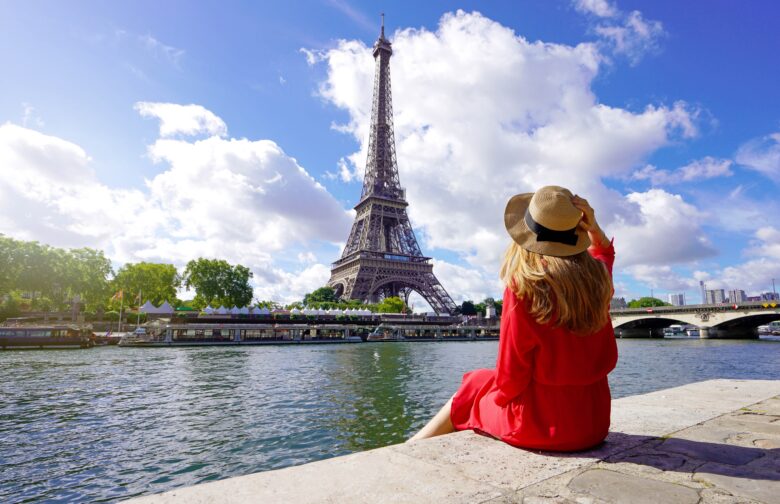
If you are lucky enough to be staying in Paris with enough time to consider day trips outside the city, you have some wonderful choices.
After you have drunk in all the sights of the City of Lights you can head out to see magnificent chateaus, quaint medieval towns, and gorgeous sandy beaches and drive through the beautifully bucolic countryside.
Here, we have chosen the best day trips from Paris. All are less than three hours away, most a lot less. Please note all driving distances are taken from La Place de La Concorde.
15 Best Day Trips From Paris
1. Versailles, one of the most popular day trips from Paris

- Distance from Paris: 18.5 km
- Driving time: 40-60 minutes via the A13
- Train details: RER C train and a 10-minute walk to the palace
One of the most magnificent palaces in the world, the royal town of Versailles is located south-west of Paris. It is one of the most popular day trips from Paris receiving over 10 million visitors every year.
The grandeur and opulence of the Palace of Versailles and the beauty of its gardens attract people with many interests offering plenty for enthusiasts of history, architecture, art, design and landscaping.
The palace began life as a humble hunting lodge and was transformed into a chateau by King Louis XIII but it is thanks to the Sun King, Louis XIV that it became the splendid palace we see today.
Louis also moved the court from central Paris to Versailles and the palace became the home of the monarchy until the French Revolution.
Construction of the palace began in 1661 and took nearly 20 years to complete but there were constant modifications, additions and new construction during its life as a royal residence. The grounds in which it stands took 40 years to complete.
The best option to make the most of a visit is the “Passport” ticket. This gives access to the four main areas:
- The Main Palace: Visitors can wander through more than 2,300 rooms. Each has its own features and attractions but top of the list to see are the incredible Hall of Mirrors, Marie Antionette’s bedrooms, the King’s apartments and the royal bedchamber.
- The Queens Hamlet: Consisting of 10 small rustic buildings around a lake in the palace park, this was built in 1783 as a retreat for Marie Antionette.
- Trianon Estate: A place of refuge away from the main palace, the estate contains the Grand Trianon Palace, the Petit Trianon Palace, the Queen’s Hamlet and ornamental gardens.
- The Gardens: Covering a huge area of 2,000 acres, the Versailles grounds contain formal gardens, 15 groves, 50 fountains, follies and a large number of statues, sculptures and other ornamental features.
2. Giverny and the french impressionism of Claude Monet
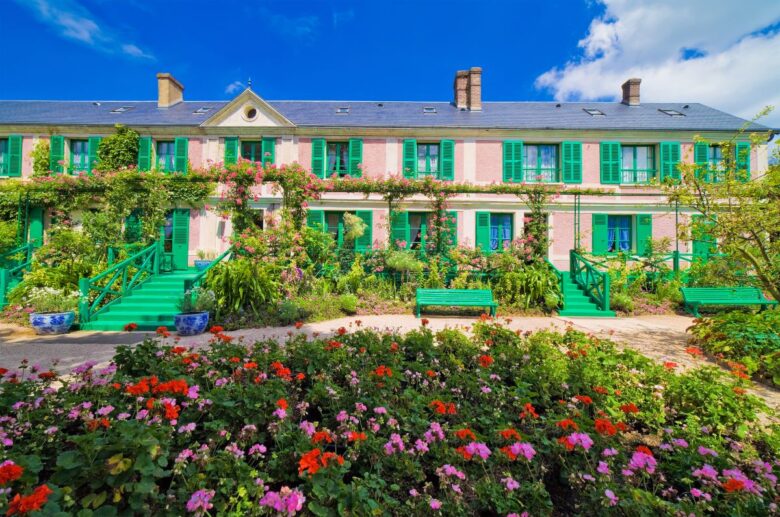
- Distance from Paris: 72.6 km
- Driving time: 60-80 minutes via the A13 and A14
- Train details: Depart from Gare Saint-Lazare, journey time 50-70 minutes
Giverny itself is a small village in Normandy but its main attraction is its association with the founder of French Impressionism, Claude Monet.
During his time in the village (1883-1926), Giverny became quite an art colony with American impressionists taking up residence and other French painters paying extended visits.
Painters were attracted not only by Monet but by what had drawn Monet there in the first place, the landscapes and atmosphere. Today, the attractions are under the umbrella of the Claude Monet Foundation.
Monet’s house is fully open to the public and visitors can wander freely through the rooms. The house is a piece of art itself, decorated in soft pastel colours with replica paintings on the walls.
The view from Monet’s bedroom highlights why he was so influenced by nature and explains much about his inspiration for the gardens.
The gardens are truly beautiful and every visitor suddenly becomes enthusiastic about the many flowers. They are even more moved by the lily pond, the subject of so many of Monet’s paintings.
Besides the lilies, the most famous attraction in Giverny is the wisteria-covered Japanese Bridge.
There are no original Monet paintings on display at Giverny but in nearby Vernon, a charming place enjoyed by the artist, there is a small museum that has one of the Nymphéas paintings.
You can also visit the Old Mill and church Collégiale Notre-Dame, both subjects painted by Monet. The 13th-century Chateau des Tourelles next to the Old Mill is a Historical Monument of France is also worth seeing.
The best time to visit Giverny is in the shoulder season because it is very busy in peak times. It is also advisable to book tickets in advance to avoid the long queues.
Remember too, while you’re in Paris, you should visit the Musée de l’Orangerie which has a custom-built gallery dedicated to Monet’s huge paintings of water lilies (as well as a world-class collection of impressionist and post-impressionist paintings from the most famous names from both art movements).
3. Mont Saint Michel, one of France’s most beautiful sights
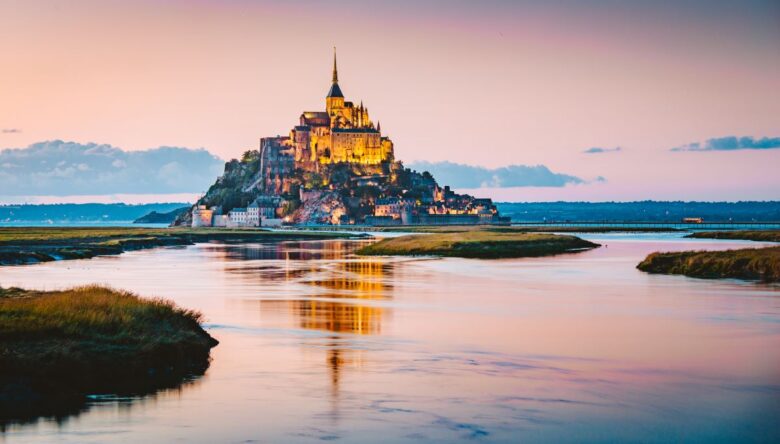
- Distance from Paris: 357.9 kms
- Driving time: 4 hours via A13 and A84
- Train details: Depart from Gare Saint-Lazare, journey time 50-70 minutes
Although a bit of a distance away, if you’re prepared for an early start and late finish, Mont Saint Michel can be achieved in a day trip from Paris.
Mont St. Michel is a tidal island approximately one kilometre off the French coast opposite the town of the same name. It is reachable via a causeway at low tide and is an inhabited island, with a population of around 30.
The island was granted UNESCO World Heritage status in 1979 for its architecture and importance as a medieval Christian site. 60 of the individual buildings are also protected as French Monuments Historiques.
Mont Saint Michel is one of France’s most beautiful sights and also one of the most important religious and historical sites. It played a strategic rule in ancient history when much of Northern France (then duchies rather than a united nation) was subject to invasion changing hands numerous times.
Construction of a major Benedictine abbey began in 966 AD and was added to continuously throughout the Middle Ages as it developed into a major seat of learning. The Abbey was also fortified (against the marauding English) and is pictured in the Bayeux Tapestry.
The island managed to remain unconquered throughout the Hundred Years War. It has served time as a prison, as decreed by Louis XI and actively housed convicts during the Ancien Régime. After the French Revolution, it remained a prison until 1869.
The importance of the abbey had waned after the reformation but restoration work was undertaken in 1874 when it was declared a national monument. Another chapter of its history is its occupation by German soldiers between July 1940 and June 1944.
The island is fully pedestrianised and most of the stone buildings date from the 13th – 16th centuries.
Things to put on your day-trip itinerary are:
- Abbaye du Mont Saint-Michel
- Chemin de Ramparts (ramparts walkway)
- Tour du Nord (North Tower) observation post
- Le Grand Rue – the island’s only street
- Eglise St. Pierre (St. Peter’s Church)
- Musée Historique (History Museum)
- Musée de la Mer et de l’Écologie (Museum of the Sea and Ecology)
- Archéoscope – a multimedia show about the construction and history of the Abbey
- Logis Tiphaine – a museum in the house of a former knight
- Auberge de La Mère Poulard – a renovated dwelling and inn famous for omelettes and biscuits
The island’s street is packed with buildings from the 15th and 16th centuries, now home to souvenir shops, snack bars, cafés, restaurants, and hotels. Wherever you venture, there are fabulous views so don’t forget to take plenty of pictures.
The best time to visit Mont St. Michel is between May and September. The weather is beautiful and mild and there is less chance of inclemency hindering a crossing.
It is peak season so will be busy but there’s also a lot of events during this period including the “Chronicles of the Mount”.
4. The Loire Valley, rural road trip from Paris with the most famous grand chateaus

- Distance from Paris: 183.9 km to Chateau Royal du Blois
- Driving time: 2 hours via A10 and A84
- Train details: Not recommended*
The Loire Valley is one of the best day trips from Paris but as public transport severely limits your options, it is best done as a road trip. On a road trip, you can visit quite a number of the chateaus the valley is famous for.
*It is possible to get to Blois from Paris by train and take a bus trip to Chambord from Blois but it is not an easy trip between the two chateaus and a long day for limited sights.
The Loire Valley is a UNESCO World Heritage-listed region roughly around the middle of the River Loire. It is an area of great rural beauty and is famous for its grand chateaus and outstanding wines.
The architectural splendour and fertile river valley are fabulous to explore and from Paris, the most easily accessible chateaus in terms of driving time are the following:
- Chateau Royal de Blois: Known as the gateway to the Loire Valley, this chateau was once the home of Louis XII, King of France. The Royal Chateau features a medieval tower, a gothic wing, a Renaissance spiral staircase and a Musee des Beaux-Arts.
- Chateau de Chambord: Widely regarded as the king of the castle and certainly the largest of the Loire castles, Chateau de Chambord is huge. Built in 1519 it has a turreted façade, 426 rooms and 83 staircases including one in the form of a double helix said to have been designed by Leonardo da Vinci. The 18th-century formal gardens are impressive too.
- Royal Chateau de Amboise: A former defensive bastion and home to the French kings between the 15th and 19th centuries, perhaps it’s even greater claim to fame is that Leonardo da Vinci is buried in the chateau’s chapel. Main attractions are the Cavalry Towers and an impressive collection of gothic and renaissance furniture.
- Chateau de Chenonceau: One of the most innovative and striking of the Loire chateaus, Chenonceau features a gallery built directly on the water. Built in a type of architecture transitional between Gothic and Renaissance, it is refined and elegant with parterre gardens.
- Villandry Château and Gardens: The last of the great renaissance chateau to be built, it is more French in style than Italian. The main attraction of Villandry is the magnificent gardens which include ornamental gardens, a herb garden, a kitchen garden and a maze.
- Chateau de Cheverny: If you’re travelling with children, this is the best of the Loire chateaus to visit. It’s very kid-friendly with a mystery tour, a historic nursery still fitted out, a TinTin museum and a maze.
To make the most of a day trip, your itinerary should cover two to three chateaus, four at most. Any more and you’ll have too little time at each stop to truly appreciate the sights.
5. Disneyland – Walt Disney Studios, one of the greatest theme parks in the world
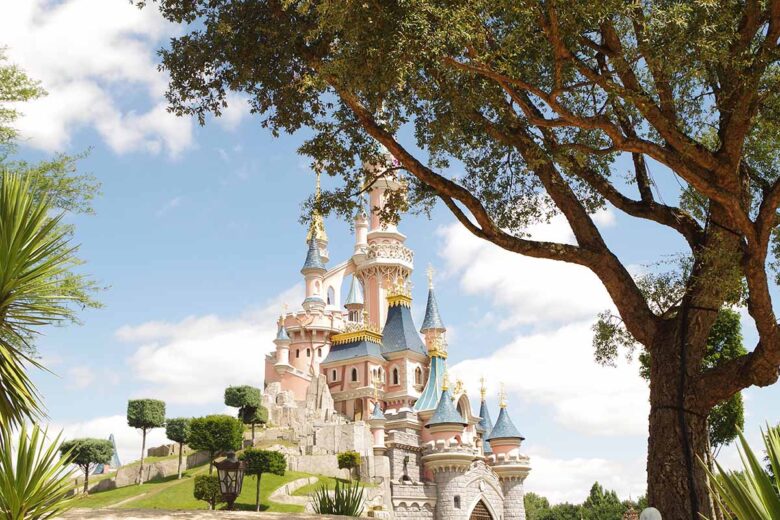
- Distance from Paris: 45.4 km
- Driving time: 45 mins via A4
- Train details: Depart from Gare de Lyon, journey time 45 minutes
What could be better than combining a trip to one of the greatest cities in the world with a trip to one of the greatest theme parks in the world? With a short travel distance, Disneyland is one of the best day trips from Paris, whatever your age.
Even better, there are two theme parks in the same location: Disneyland Park and Walt Disney Studios Park.
Disneyland: Anchored by the stunning Sleeping Beauty castle, this park brings the magic of Disney alive. All the favourite fairy tales and Disney characters await to help everyone have the time of their lives throughout various lands.
- Adventureland: Set sail with pirates of the Caribbean, take a magic carpet ride with Alladin, and search for treasure with Indiana Jones. Enjoy thrilling rides based on the adventures of swashbuckling heroes.
- Discoveryland: Budding astronauts and space cadets can jet off to Star Wars Hyperspace Mountain, tackle the evil empire in the Star Wars galaxies or join Buzz Lightyear on his quest to defeat Zurg.
- Fantasyland: Fairy tales do come true! Join Alice in her Wonderland labyrinth, meet beauties in the Princess Pavilion or take flight with Peter Pan.
- Frontierland: Get a taste of the Wild West in the saloons of Thunder Mesa or leave your spurred boots behind and go in search of spooky frights in haunted Big Thunder Mountain and Phantom Manor.
Don’t forget to take a stroll down Main Street USA with all its shops, diners and restaurants.
Walt Disney Studios Park: Star in your very own Disney or Pixar movie as you venture through the amazing wonders of some of the world’s greatest cinema.
- Marvel Universe: Be ready to take on Marvel missions along with the fantastic superheroes who are always ready to assemble to save the day.
- Front Lot: Learn all about the art of filmmaking before the advent of CGI and Walt Disney’s early career during the Golden Age of Hollywood.
- Production Courtyard: Some of the secrets of filmmaking are unearthed when you take part in a musical, pose with superheroes and take the elevator in the Twilight Zone Tower of Terror.
- Toon Studio: Aimed mostly at younger visitors, the rides and attractions here are based on Disney’s animations and are more gentle but equally enthralling.
- Worlds of Pixar: Are you ready to meet the characters of Toy Story, take a drive with Lightning McQueen, try to find Nemo or whip up a recipe with Remy the Rat?
You’ll have such a great time in Disneyland, you will definitely want to come back again.
6. Bruges, a romantic medieval city

- Distance from Paris: 296.6 km
- Driving time: 3 hours 15 mins via A1
- Train details: Depart from Gare de Nord, journey time 3 hours 30 minutes (change train in Brussels)
Bruges is a stunning medieval city in northwest Belgium. If you’re looking for a romantic setting, Bruges is easily one of the best day trips from Paris, particularly the UNESCO World Heritage-listed city centre.
Magnificently preserved, the city is full of dreamy canals, picturesque, cobbled streets lined with whitewashed almshouses, photogenic market squares, and historical churches.
There’s a lot to cram into a day. You can follow a path that takes in impressive architecture, Belgian history and the bastions of Belgian culture – beer, chocolate and lace. Here are just a few highlights:
- The Markt: The main square and one of the most impressive and certainly best preserved in all Europe.
- The Belfort: Get the best views of the city (and all the way to Zeebrugge) after climbing 366 steps to the top of the 13th-century belfry.
- Burg: Another large square, it’s home to the gothic 15th-century Stadhuis (city hall) and the Basilica of the Holy Blood.
- Groeningemuseum: Learn all about the Flemish Masters and view paintings from artists including Jan van Eyk.
- Church of Our Lady: Dates from the 13th century, has a 115 m spire and displays Michelangelo’s Madonna and Child statue from 1504.
- Kantcentrum: Learn the history of lace and see lacemaking demonstrations.
- Museum Sint-Janshospitaal: The chapel at the heart of a 12th century hospital building holds six masterpieces by Hans Memling, a 15th century devotional artists, considered Bruges’ finest painter.
- Choco-Story: Bruges’ chocolate museum is housed in a 16th century former wine cellar. Demonstrations and workshops are included in the tour.
- Canal Boat Trip: Take a leisurely cruise around the city passing under Bonifacius Bridge and Nepomucenus Bridge and past Rosary Quay.
Pause for refreshments and enjoy a Belgian beer or two in any of the seemingly hundreds of bars.
Pop into a waffle shop or tuck into some moules et frites in a small but excellent eatery. Don’t leave the city without picking up a box of exquisite chocolates.
Being so beautiful, Bruges does attract a lot of visitors so the best time to avoid the crowds is midweek. There’s extra magic in spring when daffodils carpet the courtyard of the Begijnhof Retreat and Christmas when the main square hosts one of the best festive markets in Europe.
7. Reims and Champagne, one of the best champagne routes from Paris

- Distance from Paris: 146.2 km
- Driving time: 2 hours via A4
- Train: Depart from Gare de L’Est, journey time 45 minutes
If you want to visit Champagne country, Reims is the best place to start. It is the ideal base for the Montagne de Reims Champagne Route which takes in the other great centre of champagne production, Epernay.
You can follow this specified route or simply visit both places according to your own whim.
Reims has been a strategic location throughout French history from the early days of the Roman Empire.
It suffered serious damage in both World Wars and was meticulously restored to become a place of Roman remains, fine boulevards, handsome housing and today, a flourishing fine dining scene with four Michelin-starred restaurants.
Reims is defined by its gargantuan gothic cathedral which together with the adjacent Palace of Tau, and the Abbey of Saint-Remi were inscribed to the UNESCO World Heritage list in 1991.
There is possibly no other more important church in France because between 816 and 1825, it hosted the coronation of 34 monarchs, including 24 kings.
Other attractions of Reims for your half-day tour are:
- St. Remi History Museum: Located in the Abbey of Saint-Remi, there are 17 rooms and galleries telling the history of Reims.
- Porte de Mars: At 30m long and almost 15m high, the Mars Gate is the largest known triumphal arch in the Roman world and is still practically intact.
- Villa Demoiselle: Built for the owner of Maison Pommery at the beginning of the 20th century, the house is a masterpiece blending Art Deco and Art Nouveau architecture.
- Reims-Champagne Automobile Museum: An interesting collection of more than 230 vehicles from 1908 to the present day. There’s also 5,000 toys and miniatures relating to the automotive world.
Avoid the temptation of sampling bubbly in Reims – save that for Epernay although no one will complain if you have a glass of champagne with lunch – only one mind, if you’re the driver! It is a 30-45 minute drive from Reims to Epernay.
Epernay is the self-proclaimed capital of Champagne but few would argue. Immense caverns run for 110 km under the streets of Epernay and they hold 200 million bottles of champagne from the world’s great champagne houses.
Naturally, the major attractions of Epernay are fizz related. A must is a stroll down the Avenue du Champagne, often called the Richest Street in the World.
Just a few of the famous names with “houses” on this street are Moet et Chandon, Perrier-Jouet, Mercier and Pol Roger. All offer tours and tastings.
Other attractions are:
- Hotel de Ville et Jardins: The town hall is a resplendent neo-renaissance mansion but the real draw is the gardens with a beautiful pavilion, rockery, pond and formal flower beds.
- Chateau Perrier: A mid-19th-century mansion built in the renaissance Louis XIII style, now home to a museum of champagne making and archaeological history of the region.
- Portail Saint-Martin: The last remaining ruins of the Abbey of St. Martin dating from 1540.
- Hautvilliers: This village a few minutes north of Epernay is home to the Abbaye Saint-Pierre d’Hautvillers where you’ll find the tomb of Dom Perignon.
8. Normandy, one of the best day trips from Paris

The department of Normandy has many charms and you can pick out some specific city destinations as we have done in choosing our best day trips from Paris, but you might choose themed day trips instead.
Both achievable from Paris are day tours of the D-Day Beaches and the holiday hotspots of the Normandy coast.
D-DAY LANDING BEACHES
- Distance from Paris: 236 km (to Caen)
- Driving time: 2 hours 30 minutes via A13
- Train: Depart from Gare Saint Lazare, journey time 2 hours
It is feasible to visit the beaches by public transport because the museum in Caen runs regular guided tours throughout the day.
Driving the area enables you to take a wider tour. You can visit each of the D-Day beaches as well as specific points of interest:
- Caen Memorial Museum: Also home to the Caen Memorial, here you can learn in-depth the story of June 6th, 1944, the D-Day landings.
- Pointe du Hoc: Monument and museum depicting the assault by American Rangers that inspired the opening of Saving Private Ryan.
- Normandy American Cemetery and Memorial: Located in Colleville-sur-Mer, it contains the graves of more than 9300 American servicemen.
- Bayeux: A stop in this gorgeous medieval town is a must. Not only is it home to the British Military Cemetery and Memorial but the Bayeux Tapestry hangs in the museum.
Of particular interest to British visitors, because it is the birthplace of William the Conqueror, Bayeux has a particularly fine gothic cathedral (Notre-Dame de Bayeux).
NORMANDY SEASIDE
- Distance from Paris: 197.4 km (to Deauville)
- Driving time: 2 hours 15 minutes via A13
- Train: Depart from Gare Saint Lazare, journey time 2 hours
If your idea of the best day trips from Paris are to the seaside, the closest beaches to Paris are those of Normandy. Here’s our pick of the top five beach destinations.
- Deauville: An upscale resort on the Cote Fleurie known for its American Film Festival, casino, horse racetrack and golf courses, Deauville’s beach is wide and sandy, dotted with brightly coloured parasols and backed by a 1920’s celebrity boardwalk.
- Honfleur: This picture postcard town with a quaint harbour and old half-timbered houses with slate roofs was a favourite of impressionist painters including Monet. Beautiful Butin Beach is large and sandy and boasts natural rock pools at low tide.
- Etretat: Yes, there are beaches but it is the astonishing white cliffs and three rock arches that are the main attraction of Etretat. The beaches are of white pebbles rather than sand but it is the cliffs that you come for. The old town centre is pretty too.
- Cabourg: Similarly to Deauville, Cabourg brings the Golden Age to mind with its seafront villas, racecourse and casino. It too has the romantic film Festival as well as Cabourg Mon Amour, a music festival. The fine sand beach runs for more than 4 km as does the Marcel Proust promenade.
- Trouville-sur-Mer: If you want more of a fishing village vibe, head for Trouville. Its Belle Epoque charm seduced Monet and Proust and it’s less decadent than its sister over the river, Deauville. Great for families, the beach is sandy and offers many water sports.
9. Provins, fortified medieval town

- Distance from Paris: 93.2 km
- Driving time: 1 hour 30 minutes via N4
- Train: Depart from Gare de L’Est, journey time 1 hour 30 minutes
Another of France’s UNESCO World Heritage Sites, Provins is a fortified medieval town dating back to the 11th century.
It makes one of the best day trips from Paris because there is masses to see yet it is not so well known as to make it packed with tourists. You can happily stroll the cobbled streets, walk along the ramparts and pass through the fortified gates.
Key attractions are:
- Tour Cesar: The medieval tower dates back to the 12th century and if you can manage the very steep steps, you’ll be rewarded with spectacular views.
- Medieval Tunnels: running in a intricate maze beneath the lower part of the medieval town, the walls are scrawled with writings and pictures chronicling life in Provins.
- Musée de Provins et du Provinois: Housed in the 12th century Maison Romane, it exhibits the history of Provins from prehistory to the 19th century as well as some rare culturally significant objects.
- La Grange aux Dimes: The preserved medieval architecture belongs to a former merchant’s house that was also once a covered market and then a storehouse for tithes. Today it is an exhibition on medieval merchants and craftsmen’s guilds.
- Rose Gardens: Overlooking the Old Town, the 3.5-hectare gardens hold more than 450 varieties of roses. There’s also a medicinal garden and tea room.
10. Chantilly, small, elegant and select
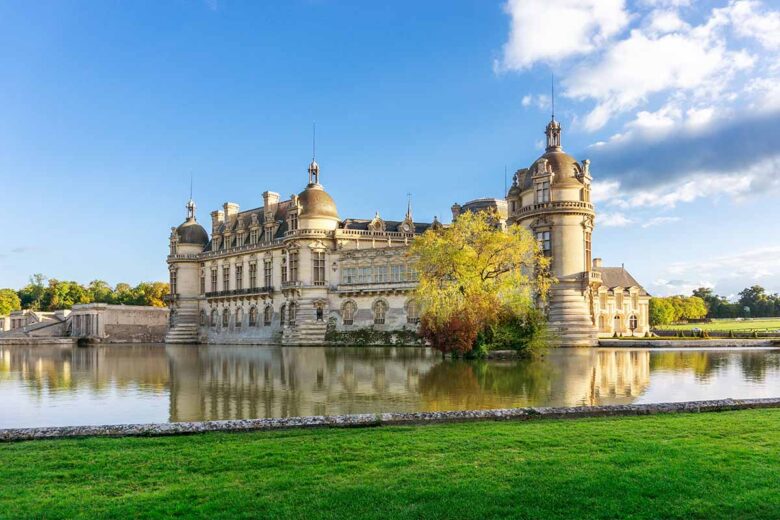
- Distance from Paris: 56.2 km
- Driving time: 1 hour via N4
- Train: Depart from Gare du Nord, journey time 30 minutes
Think chateau, horses, cream and lace and you have summed up Chantilly in four words. Chantilly is small, elegant and select.
Its prominence grew to the chateau that first belonged to the House of Montmorency, then the Condés and was once home to Henri d’Orleans, the fifth son of the Last King of France, Louis Philippe I.
Things to see on a day trip:
- Domaine de Chantilly: Originally two separate homes and now joined by a gallery, the opulent fairy tale chateau stands in a magnificent 115-hectare park that includes 25 hectares of water gardens, an English garden and an Anglo-Chinese garden. A historic monument, the chateau is open to the public.
- Musée Condé: The art gallery within the chateau is the legacy of Henri d’Orleans and only the Louvre has a larger collection of antique paintings in France. There’s also a collection of 1,300 manuscripts.
- Chantilly Racecourse: A premier racetrack, it hosts two of the French classics in June.
- Grandes Écuries: The Grand Stables are one of the most visited horse-racing sites in the world. It also houses the Living Museum of the Horse. Dressage demonstrations are held daily.
- Musée de la Dentelle: Although the eponymous lace is no longer made in the town, Chantilly lace originated here. The museum tells its story.
- Le Potager des Princes: A addition to the town’s attractions as recently as 2002, the Vegetable Garden of the Princes features ornamental gardens, waterfalls, fountains, outdoor theatre, art gallery and petting zoo.
11. Auvers-sur-Oise
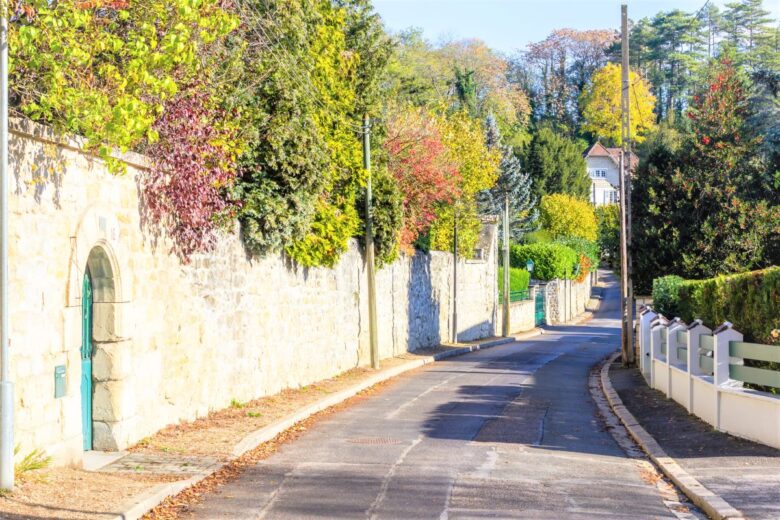
- Distance from Paris: 35.1 km
- Driving time: 45 minutes via A115
- Train: Depart from Gare du Nord, journey time 35 minutes
You know there is something about a place when it attracts artists the likes of Paul Cézanne, Camille Pissarro, Charles-François Daubigny and Vincent Van Gogh (who actually died here in 1890). Auvers-sur-Oise is a small and peaceful town and is a lovely day out, especially for art lovers.
Though very closely associated with the impressionists and post-impressionists, there are associations with movements right up to the end of the 20th century. It’s a must for all fans of Van Gogh.
The main attractions are:
- Chateau d’Auvers: A 17th-century estate in the style of Louis XIII, its 9-hectare gardens are stunning in summer. The chateau presents a wonderfully historic setting for an immersive interaction with 19th-century impressionism.
- L’église Notre-Dame-de-l’Assomption: The Auvers church was immortalised by Van Gogh in 1890 and the painting is on display in the Musée d’Orsay in Paris.
- Van Gogh’s Grave: After his fatal gunshot wound, Van Gogh was laid to rest in the town cemetery in Auvers-sur-Oise. His brother Theo lays beside him after his body was moved from its original grave in Utrecht in 1914.
- Musée de l’Absinthe: Dedicated to the alcoholic spirit known as the Green Fairy, the museum recreates the Belle Epoque era when absinthe was a favourite in the cafes and bars.
- Musée Daubigny: Daubigny’s old home and workshop is now a museum dedicated to his work and that of many of his contemporaries and artists that followed, most of whom who have been inspired to visit Auvers.
12. Rouen, capital of Normandy

- Distance from Paris: 133.1 km
- Driving time: 1 hour 45 minutes via A13
- Train: Depart from Gare Saint Lazare, journey time 1 hour 30 minutes
Packed with turbulent history, Rouen is the capital of Normandy.
Its rich stories include devastating plagues and fires in the Middle Ages, occupation by the English during the Hundred Years War and the demise of Joan of Arc when she was tried for heresy and burned at the stake in the city’s central square in 1431.
Roeun also suffered major damage during allied bombing raids in World War II.
Rouen stands on the River Seine and was founded by the Galls and overtaken by the Romans. It became the capital of Normandy in 912 and William the Conqueror resided here until he moved his court to Caen.
Normandy was annexed to France in 1204 and Rouen continued to grow. Throughout the Middle Ages strife, Rouen was at the centre of power struggles, war, battles and even a major siege but survived. Today, Rouen is the fifth largest seaport in France.
The reasons to visit Rouen are its ancient charm, endless cobbled streets many of which are pedestrianised, the imposing gothic cathedral and one of France’s most impressive clock towers.
The attractions of Rouen:
- Rouen Cathedral: The Cathédrale Notre-Dame de Rouen is the tallest church in France and boast three immense towers each in a different architectural style. It features from Early Gothic to late Flamboyant and Renaissance architecture and has a claim to fame as being the subject of many paintings by Claude Monet. It is also home of the embalmed heart of Richard I of England, Richard the Lionheart.
- Gros Horloge: One of the most beautiful astrological clocks in France, the Grand Clock of Rouen is also one of the oldest working time movements. Installed in a Renaissance arch over the Rue du Gros-Horloge, it dates to 1389.
- Musée des Beaux-Arts de Rouen: Established by Napoleon Bonaparte in 1801, the museum contains fine antiques and objets d’art from all over France mainly dating from 1500 to the 1900s.
- The Jardin des Plantes: Dating from 1840, this notable botanical garden was once owned by Scottish banker John Law. It is the city’s largest green space and is filled with amazing plants year-round.
- Palais de Justice: Located next to the cathedral, the gothic façade of the courthouse is extremely photogenic. A historic monument, it dates from the 15th century.
- Tour Jeanne D’Arc: The tower is all that remains of Rouen Castle. It dates to 1204.
Other attractions you might consider visiting if time allows are the ceramics museum, Musée Le Secq des Tournelles (museum of wrought iron), Church of Saint-Maclou, Historial Jeanne d’Arc (museum) and the Church of Saint-Oeun.
As with most of the best day trips from Paris, spring and autumn are the best times to visit Rouen to avoid hordes of tourists.
13. Fontainebleau, one of the most popular best trips from Paris
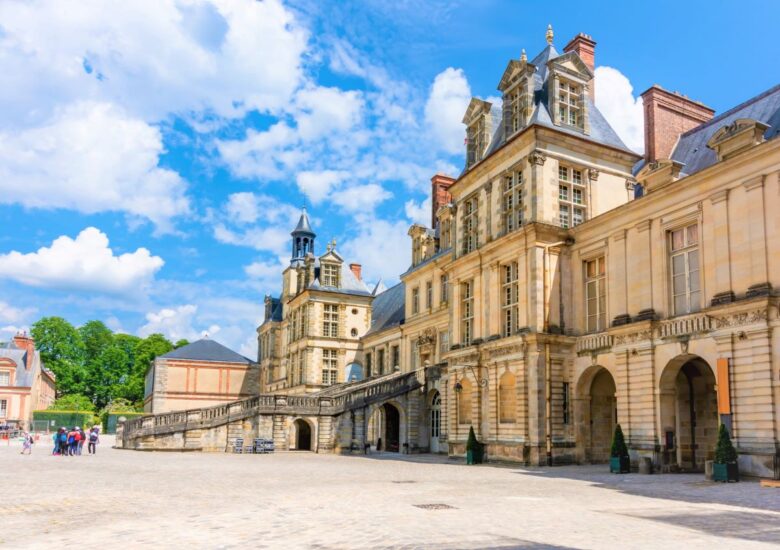
- Distance from Paris: 73.3 km
- Driving time: 1 hour via A6
- Train: Depart from Gare de Lyon, journey time 45 minutes
Another of the great chateaus, the Palace of Fontainebleau has been a formal royal residence with monarchs including King Louis VII and Napoleon III. It has been a museum since 1927 and a UNESCO World Heritage Site since 1981.
The earliest record of construction at Fontainebleau dates to 1137. Like many of the royal chateaus, it began life as a hunting lodge. Various French kings had associations and it is known that Thomas Becket (later the Archbishop of Canterbury) consecrated the chapel here in 1169.
In 1528, King Francis I ordered the construction of a palace in the renaissance style and during this period, the masterpiece now known as the Gallery of Francis I was created. An Italian renaissance garden was also added.
Henry II and Catherine de Medici took over Fontainebleau in 1547. They continued the expansion and extension of the chateau, adding a new grand ballroom and new king’s apartments (later destroyed). In 1565, Catherine ordered the construction of a defensive moat.
Under King Henry IV, even more expansive changes were made with the construction of new courtyards, galleries and gateways. He also directed more works for the gardens.
From 1610 onwards, the chateau was subject to the usual rounds of extension, renovation, remodelling and refurbishment as expected of a royal residence each time there was a new monarch.
The last royal to make changes to Fontainebleau was King Louis XVI who extended the chateau to create more space for his courtiers. He and his wife, Marie Antoinette made their last visit to the royal palace in 1786, just before the outbreak of the French Revolution.
Fontainebleau came through the revolution unscathed except for the loss of its furniture and Napoleon Bonaparte installed a military school in 1803. Bonaparte also directed much new work but rarely visited.
The chateau’s main purpose was to be a prison for Pope Pius VII. Bonaparte did return to Fontainebleau at the end of his reign and it was here he abdicated in 1814.
During the restoration of the monarchy Kings Louis XVIII and Charles X each stayed at Fontainebleau but for short periods. Emperor Napoleon III made restorations during the Second Empire but when the empire fell in 1870 Fontainebleau closed.
The chateau changed hands and suffered various military occupations until it was classified as an historic monument in 1913. It was occupied by the Germans in WWII and passed into the Allies hands until 1966. President Charles de Gaulle ordered the chateau’s restoration between 1964 and 1968.
Some of the most popular sights in Fontainebleau are:
- Francis I Gallery: One of the finest examples of renaissance decoration in France, it features woodwork and stucco framed murals.
- Ballroom: A huge room with a grand fireplace and musicians gallery, richly and ornately decorated.
- Room of the Guards: A large space with vaulted ceilings, exotic hardwood floor, a frieze of military trophies and a monumental fireplace.
- Queen’s Bedroom: The ornate and sumptuously furnished bedchamber has been the sleeping place for all of the Queens and Empresses of France from Marie de Medici to the Empress Eugènie.
- Boudoir of Marie-Antoinette: the fanciful decoration is fitting for a retreat next to the Queen’s bedroom.
- Napoleone’s Throne Room: The former king’s bedroom was converted in use only. Some alterations were made but the main change was the installation of a throne which came from the Tuileries Palace. Napoleon took one of the king’s dressing rooms as his bedroom. Of the 1500+ rooms, others of note include the Council Chamber, apartment of the Pope and of the Queen-Mothers, St. Saturnin’s Chapel, Chapel of the Trinity, Gallery of Diana, the theatre and the Chinese Museum.
Don’t forget to spend some time in the landscaped gardens and it is also worth taking a stroll into the small historic town of Fontainebleau.
14. Chartres, one of the best day trips from Paris for lovers of history and gothic architecture

- Distance from Paris: 95.1 km
- Driving time: 1 hour 15 minutes via A10 and A11
- Train: Depart from Montparnasse, journey time 1 hour 15 minutes
One of the best day trips from Paris for lovers of history and gothic architecture is to Chartres, capital of the Eure-et-Loir region. Another of the great French cathedral cities, Chartres also boasts a well-preserved timber-framed Old Town.
Steep streets and staircases wind downhill to the Eure River crossed by a number of footbridges. It is particularly beautiful and romantic in spring when masses of cherry blossom and wisteria are in bloom.
Like any place of significance in Northern France, Chartres was heavily involved in the power struggles between nations, duchies and monarchies throughout the Middle Ages.
The exchanges of power left its marks on the fabric of the city but the cathedral stood through it all.
Chartres Cathedral: The UNESCO World Heritage Site, the 12th-century Notre Dame cathedral is one of the finest and best-preserved gothic cathedrals in France and in Europe.
It is particularly known for not being symmetrical in design (two different towers) but mostly for the dazzling blue glass in the stained windows. To this day, it is not known how the blue colour was produced.
Chartres cathedral is also a site of pilgrimage. Among its relics is the Sancta Camisa or Sainte Voile, supposedly a piece of clothing worn by Mary at Jesus’ birth.
Another of its famous features is the labyrinth on the floor of the nave which dates to the early 1200s and there is a 24-hour clock on one of the facades, created in 1520.
Other attractions of Chartres:
- Centre International du Vitrail: Housed in the 13th-century Grange aux Dimes, a former barn and historic monument, the International Stained Glass Centre holds exhibitions and demonstrations.
- Musée des Beaux Arts: Located in a former episcopal palace just behind the cathedral, the museum features artworks from the Middle Ages to the present day.
- Conservation Area: Part of the Old Town, you can get lost in the quaint cobblestone streets for a while. Of particular note are Rue des Écuyers (equerries street) and Rue Chantault.
- Maison Picassiette: In stark contrast to the timbered houses of the Old Town, this quirky house is covered in 15 tonnes of pottery fragments that took 29,000 to be applied.
- Le-Petit-Chart’Train: Take the easy way and hop on board the tourist train that runs on a 35 minute loop past the main sights.
15. Lille, a taste of French Flanders

- Distance from Paris: 227 km
- Driving time: 2 hour 15 minutes via A1
- Train: Depart from Gare du Nord, journey time 1 hour
Close to the Belgian border and capital of the Hauts-de-France region, Lille is a taste of French Flanders. It is one of the most underrated French cities (and actually the fourth largest!) and flies under the radar as a tourist destination.
The town’s historic centre is nicely compact which makes it ideal for exploring on a day trip, there’s a lively atmosphere created by a large student population and as a former World Design Capital, it is a hub of modern creativity and innovation.
There’s a quite wonderful dichotomy of gothic architecture and medieval history and contemporary design.
Things to see and do in Lille:
- Old Lille: Wander around cobblestone streets admiring restored bourgeois houses in baroque architecture from the 17th and 18th centuries. Place Louise de Bettignies and Rue de la Monnaie are worthy stops.
- Grand Place: Lille’s main square is bound on all sides by old gabled buildings and at its centre is the Colonne de la Déesse, a monument to the 1792 Siege.
- Palais des Beaux-Arts: Second only in size to the Louvre, the museum is housed in a beautiful Belle Époque summer palace dating from the end of the 19th century. It holds art from the 1400s to the 1900s.
- La Vieille Bourse: considered by many to be Lille’s finest building, the 17th-century stock exchange is 24 Flemish renaissance houses set around a cobbled courtyard.
- Town Hall and Belfry: In stark contrast to the rest of central Lille, the town Hall is a striking art deco building erected in the 1920s. The top of the Belfry offers wonderful views.
- Lille Zoo: One of the most visited animal and natural attractions in France, the zoo is home to more than 450 animals.
- LaM: A must for modern art lovers, the museum holds more than 6,700 works from the 20th and 21st centuries, including an outdoor sculpture park.
We think there’s something for everyone in the best day trips from Paris. Your only dilemma is choosing which you’ll enjoy most.